The Brooklyn-based artist Nicole Eisenman’s first UK retrospective is satirical, sexy, smutty and exhilarating. It leaves you reeling from the assault of styles, colours, mediums and registers that she seems to slip between effortlessly. Titled ‘What Happened’, the show at the Whitechapel Gallery in London chronicles Eisenman’s development as an artist in tandem with three decades in America that have encompassed 9/11, a banking collapse and the police murder of George Floyd. These thematic strands broadly frame the exhibition, which runs chronologically from the 1990s to the present.
Two walls are dedicated to Eisenman’s early drawings, in a sense the backbone of her practice. Here we witness how the artist absorbs popular culture and queers it: there’s Wilma from the Flintstones giving it hard to Betty, Alice in Wonderland with her head up Wonderwoman’s crotch, saucy games of naked lesbian Twister and Amazonian tribes castrating pirates. In these displays Eisenman tests out compositions and styles, from cartoon strip to art historical quotes. The same subversive wit underpins her paintings from this time. In Lemonade Stand (1994) a ladder of women pees into jars in a dynamic relay to supply the drinks’ stall, while Swimmers in the Lap Lane (1995) taps into the erotic potential of fleshy encounters with strangers in a pool, envisaging passing swimmers groping each other and making out.
Eisenman veers in tone between poignancy and high melodrama as she grapples on canvas with the role of the artist and its vicissitudes. The Humiliation of Being an Artist (1996–2011) depicts a doe-eyed caricatured misfit towering over and ignored by ordinary people, while Commerce Feeds Creativity (2004) portrays a sinister gallerist type force-feeding the naked, drooling and bound artist, who calls to mind a baroque martyr. In Were-artist (2007), the tragicomic loner at the easel has sprouted hairy talons under the full moon and stands uncertainly before a canvas built up with impasto, reflecting, according to the exhibition catalogue, a shift towards greater texturing in Eisenman’s work.
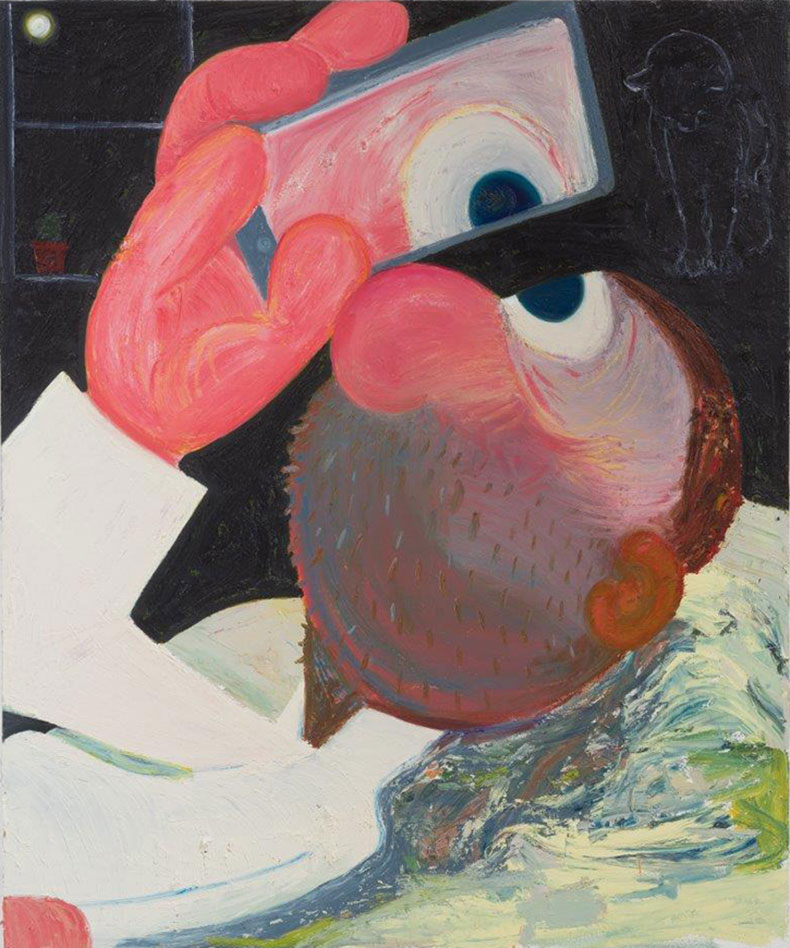
Selfie (2014), Nicole Eisenman. Collection of Stephanie and Timothy Ingrassia
Friends and family are incorporated into the mix – we peer into an awkward Seder dinner; a session with Eisenman’s psychiatrist father; a drunken bar smooch and grim beer garden scenes channelling Renoir and German Expressionism. Works from the past decade reflect on technology’s hold on our everyday lives, epitomised by Selfie (2014): a cartoonish figure holding a phone so close that it becomes an extension of its bug-eyed face.
In recent years Eisenman’s interest in sculpture has grown and two rooms are given over to her material experimentation with heads. Representations of heads line the walls in woodcuts, etchings, mixed media monotype, foam and oil on board and oil on cast aluminium. In dialogue with these are four large bronze busts (2018–19), perhaps depicting characters or archetypes such as the General and the Professor. Eisenman seems to bring them down to size with playful details: the Eagle, that august symbol of America, has a dog lead around its base, a cuckoo clock in a recess in its back, and yellow splodges of clay oozing unceremoniously from its cast aluminium surface. Meanwhile, Maker’s Muck (2022) offers a self-portrait via a crude figure endlessly turning wet clay and surrounded by rough creations.
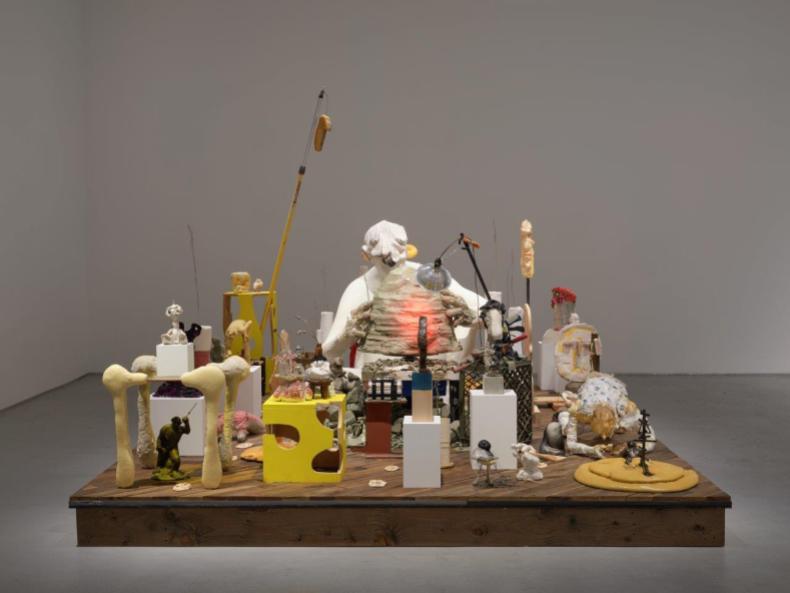
Maker’s Muck (2022), Nicole Eisenman. Moderna Museet
These works have undeniable vitality but lack the power of, say, her history paintings. In the 2000s, with America occupied by two wars, an economic downturn and the climate crisis, Eisenman brings her mordant socio-political observations to life through bold colours and a collision of styles. In Coping (2008) a ragtag group forlornly picks their way through a brown river as fecal clouds float in a lurid yellow sky. A smoking banker in bowler hat and braces holds the centreground, surrounded by a naked woman (resembling the artist), a man exuding Munch-like angst, a bandaged mummy and a spectral figure, the latter recalling the deathly apparitions that populate James Ensor’s paintings. The Triumph of Poverty (2009) is another tour de force interweaving references to Holbein, Brueghel and Dickens in its portrayal of the human fallout of capitalist excess. Titled after a lost painting by Hans Holbein the Younger, it shows an Oliver Twist character holding out a bowl for more and, bound to a banker with his pants down, a diminutive procession of figures taken from Pieter Brueghel the Elder’s The Blind Leading the Blind (1568). Equally thrilling are Eisenman’s more recent large-scale canvases responding to America’s shift towards the far right. In wasted landscapes under sickly skies staunch patriarchs pursue the path of darkness. The Darkward Trail (2019) has an apocalyptic feel, its three oddball subjects taking up the role of border vigilantes hunting migrants through an eerily desiccated vista.
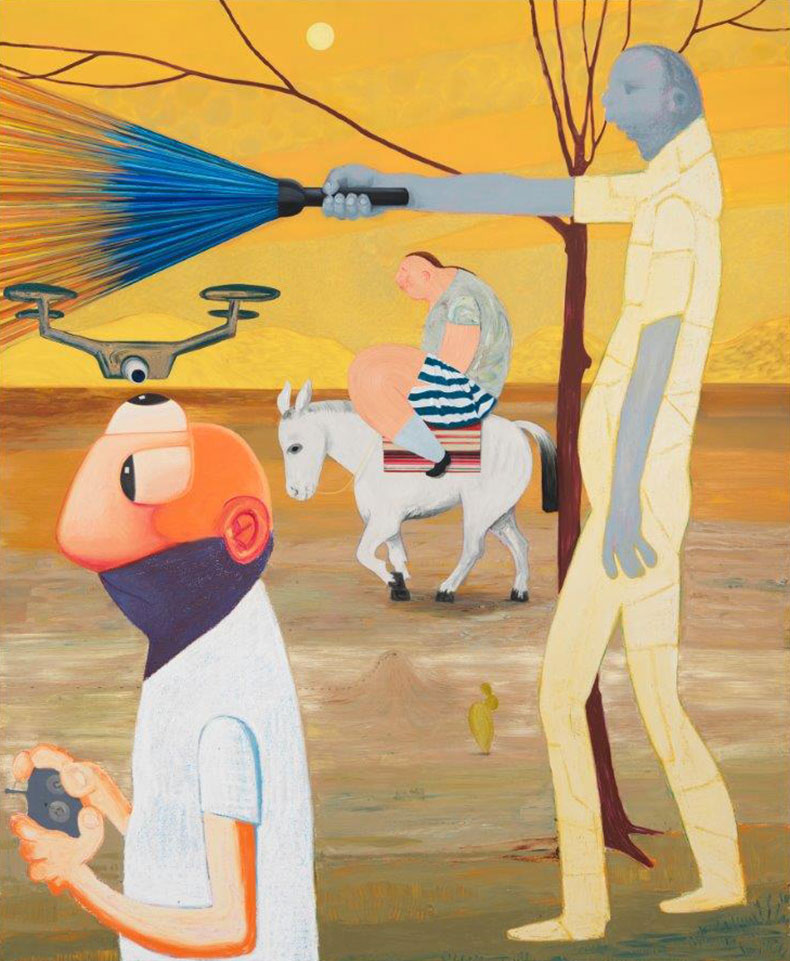
The Darkward Trail (2018), Nicole Eisenman. Tate
‘What Happened’ is an enthralling journey through Eisenman’s mind as she makes sense of the fraught period she has lived through and her own calling as an artist. Part of the magic of her phantasmagorical canvases lies in their fusion of opposing elements – fantasy with verisimilitude, caricature with Egyptian frieze or post-Impressionist elements. But what lingers for me is their resounding humanity. From ambitious group narratives to moments of intimate tenderness, it’s the vulnerability that makes them relatable. Observer and observed, Eisenman paints herself into her scenes and recounts with unflinching candour WTF Happened.
‘Nicole Eisenman: What Happened’ is at the Whitechapel Gallery, London until 14 January 2024.
Unlimited access from just $16 every 3 months
Subscribe to get unlimited and exclusive access to the top art stories, interviews and exhibition reviews.


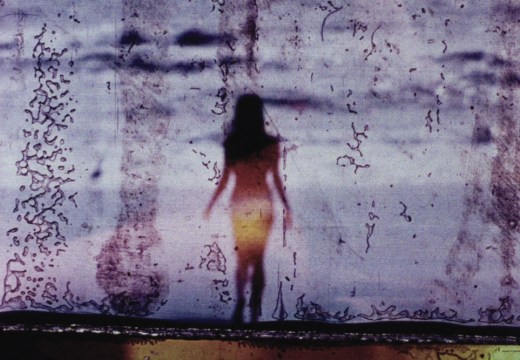
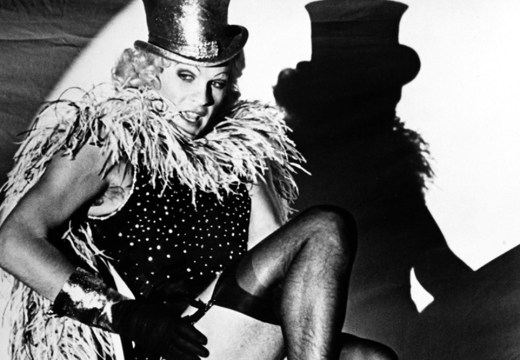
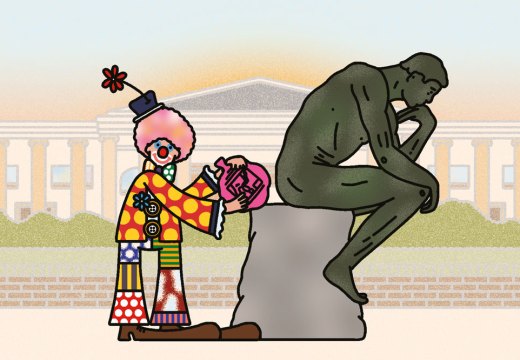









![Masterpiece [Re]discovery 2022. Photo: Ben Fisher Photography, courtesy of Masterpiece London](http://www.apollo-magazine.com/wp-content/uploads/2022/07/MPL2022_4263.jpg)
It’s time for the government of London to return to its rightful home